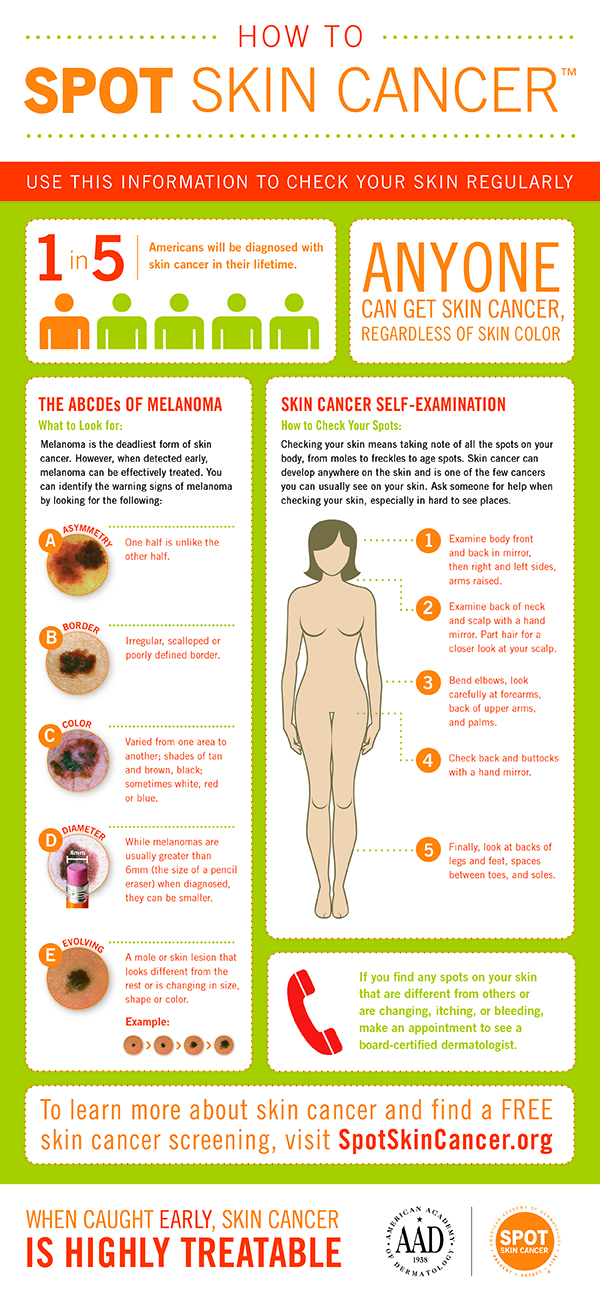MAY IS SKIN CANCER & MELANOMA AWARENESS MONTH
MONDAY, MAY 5th IS MELANOMA MONDAY.
You may not know this, but I happen to have the BRCA Genetic mutation for Breast and Ovarian Cancer. It means my risk for developing those two cancers are exceedingly greater than the general population, with my lifetime risk of breast cancer reaching the 90 percent region as I age.
BUT WHAT DOES THE BRCA GENE have to do with SKIN CANCER, YOU ASK?
A little known fact is that people who are BRCA1 and 2 positive are also at greater risk of developing all kinds of skin cancers too. Even though the percentages don’t reach the 90’s, we’re still at greater risk. So, as you can imagine, I’m very interested in what can be done to prevent skin cancer, and finding the best early detection practices.
And so, in honor and in observance of Skin Cancer Awareness Month in May, I am so pleased to offer you some helpful information about early detection and prevention from the American Academy of Dermatology.
It is estimated that one in five Americans will be diagnosed with skin cancer in the course of their lifetime, and one person dies from melanoma – the deadliest form of skin cancer – every hour.
In recognition of Melanoma/Skin Cancer Detection and Prevention Month® in May and Melanoma Monday®, observed on May 5, the American Academy of Dermatology (Academy) is encouraging the public to learn how to SPOT Skin Cancer™. The campaign aims to save lives by emphasizing the importance of early detection.

“When caught early, skin cancer is highly treatable,” said board-certified dermatologist, Brett M. Coldiron, MD, FAAD, president of the Academy. “Despite this, many people don’t know how to be their own detective when it comes to skin cancer, including what to look for on their skin or when they should see a dermatologist.”
To increase people’s chances of spotting skin cancer early, the Academy recommends everyone learn the ABCDE rule, which outlines the warning signs of melanoma:
- A – is for Asymmetry: One half of the mole does not match the other half.
- B – is for Border irregularity: The edges are ragged, notched or blurred.
- C – is for Color that varies from one area to another.
- D – is for Diameter: While melanomas are usually greater than 6mm (the size of a pencil eraser) when diagnosed, they can be smaller.
- E – is for Evolving: A mole or skin lesion that looks different from the rest or is changing in size, shape or color.
“Although skin cancer is more common among people with light or fair skin, everyone is at risk of getting this life-threatening disease,” said Dr. Coldiron. “SPOT Skin Cancer™ encourages people to invest in their health and spot skin cancer early, when it is most treatable. If you see anything on your skin that is changing, itching or bleeding, you should make an appointment to see a board-certified dermatologist.”
HERE ARE SOME OTHER USEFUL RESOURCES ON THE ACADEMY OF DERMATOLOGY’S SPOT Skin Cancer™ website – www.SpotSkinCancer.org SO YOU CAN GET IN TO SCREEN / TEST FOR HEALTHY SKIN!!!
- The SPOT Skin Cancer™ Quiz to test how much you know – or don’t know – about skin cancer
- How to find a free skin cancer screening in your area: nearly 500 screenings are available nationwide in May
- A How to Select a Sunscreen infographic with tips for choosing a sunscreen that reduces your risk of skin cancer and early skin aging
And because I think it’s extremely helpful, HERE is that sunscreen info graphic:





